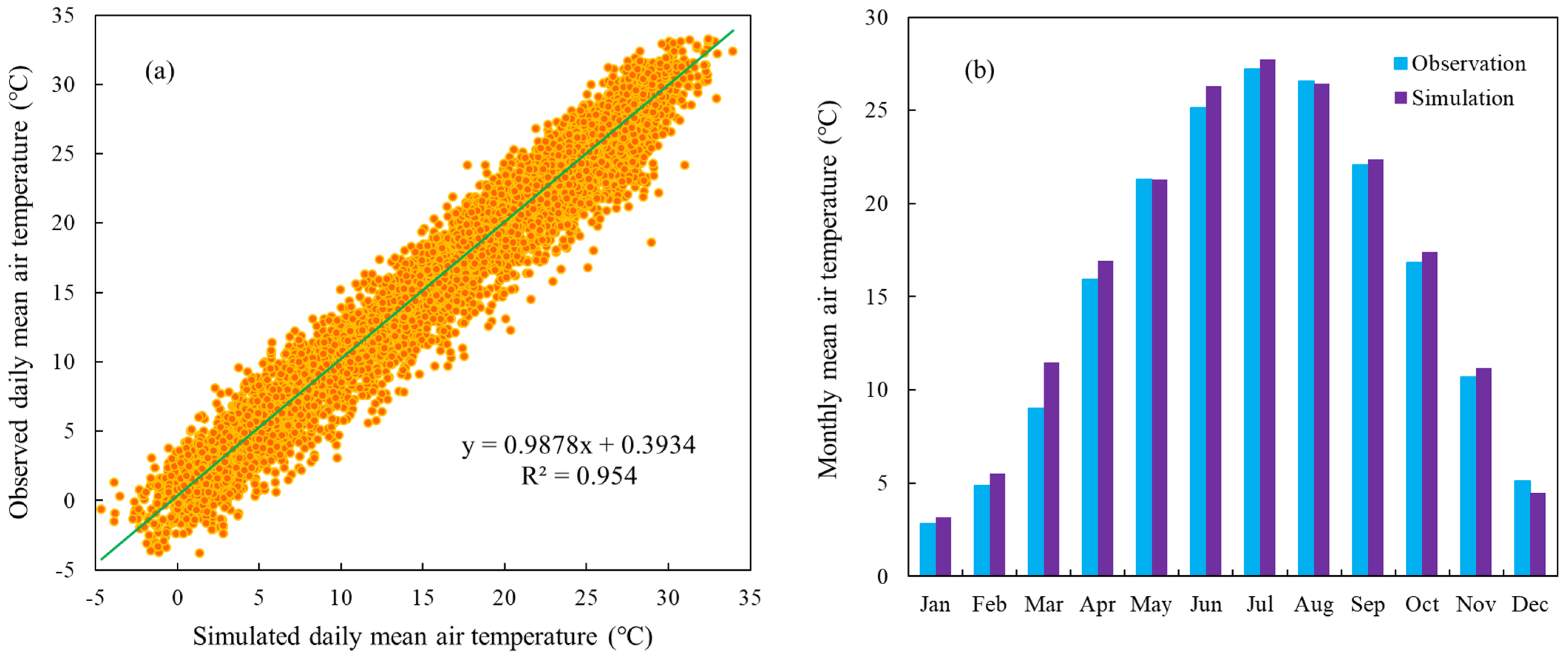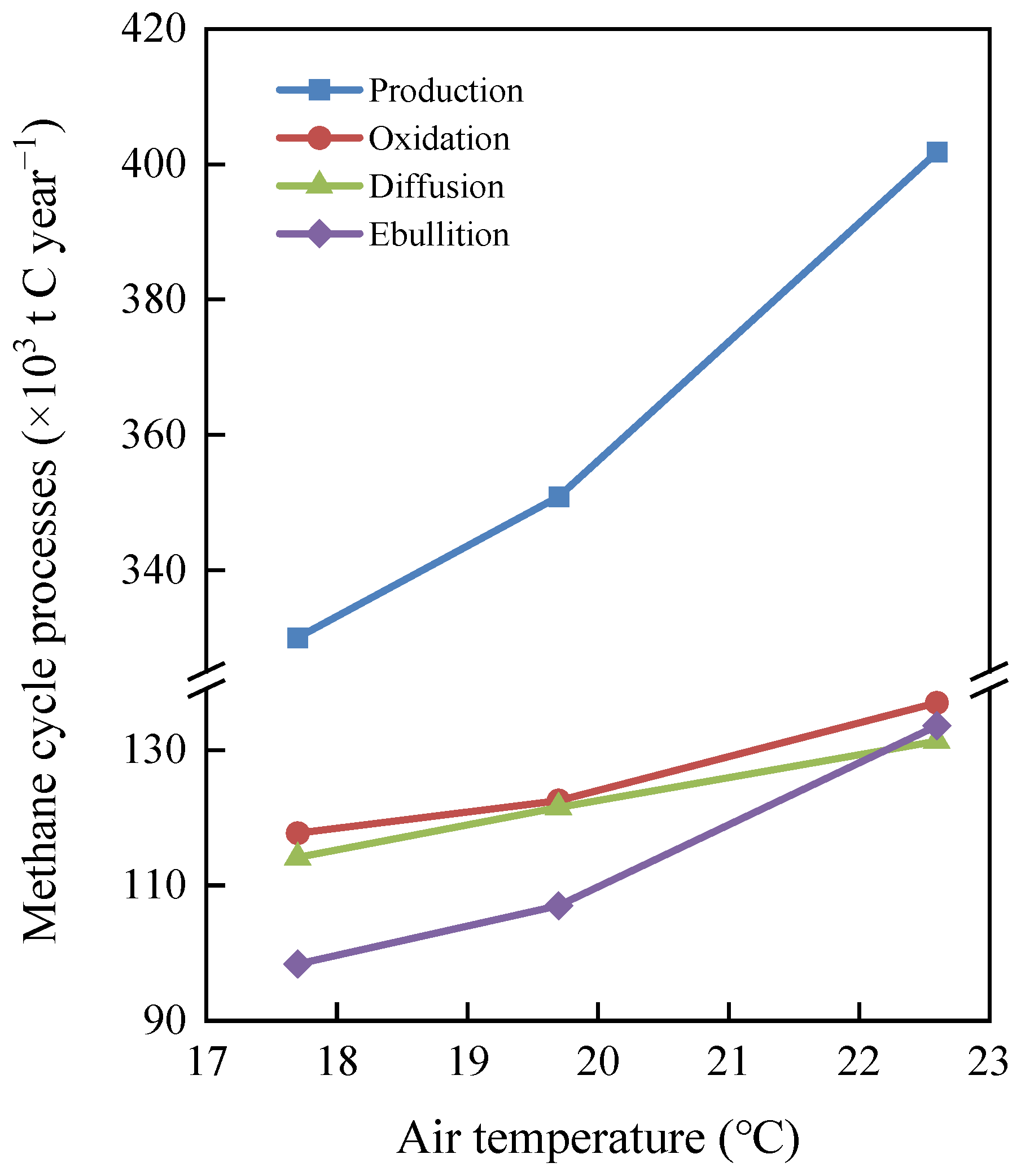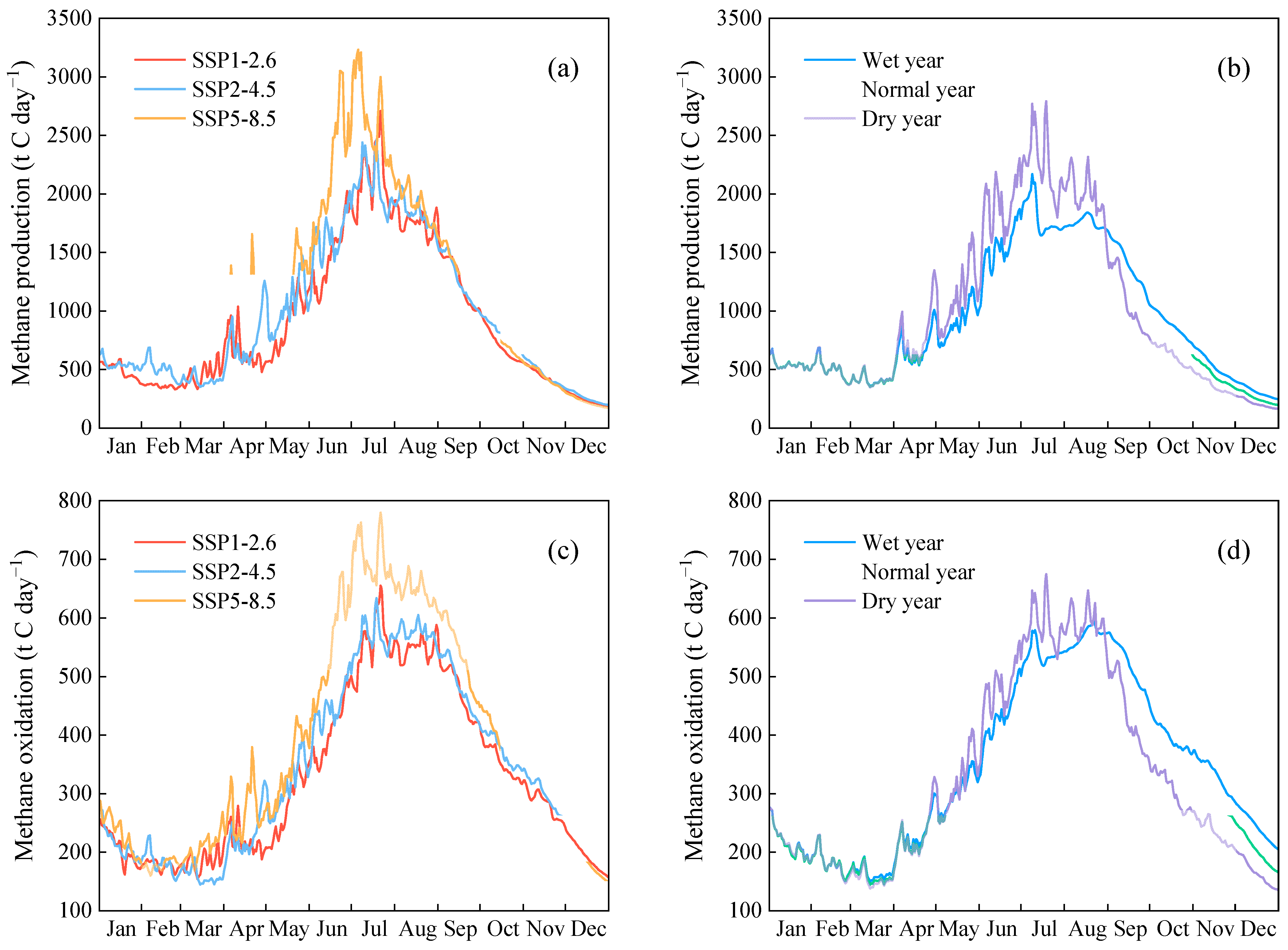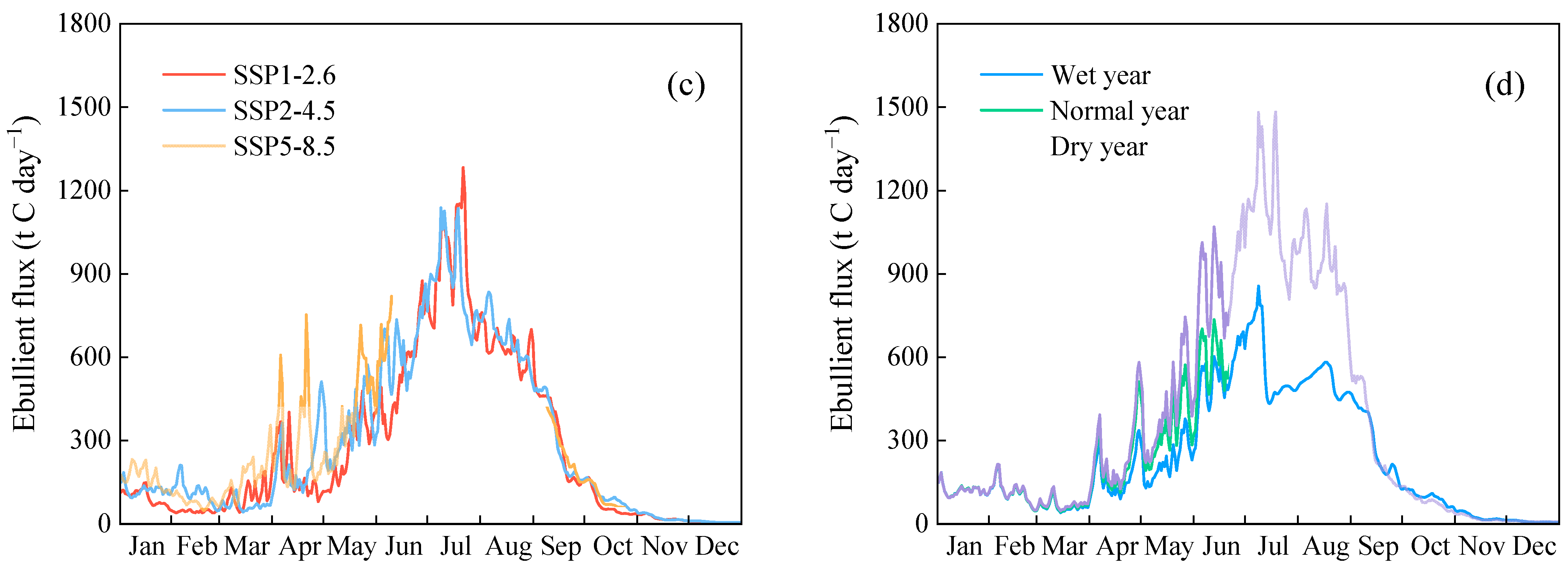Evaluating the Feedback of the Reservoir Methane Cycle to Climate Warming under Hydrological Uncertainty
Abstract
1. Introduction
2. Materials and Methods
2.1. Study Area
2.2. Reservoir Methane Cycling Simulations
2.3. Air Temperature Prediction and Hydrological Uncertainty
2.3.1. Near-Surface Air Temperature Prediction
2.3.2. Hydrological Uncertainty Analysis
3. Results and Discussion
3.1. Air Temperature Prediction
3.2. Dynamic Variations of Sediment Methane Budgets
3.3. Spatiotemporal Feedback of Sediment Methane Production and Oxidation
3.4. Feedback of Sediment Methane Emissions
3.5. Reservoir Methane Emission to the Atmosphere
4. Conclusions
Author Contributions
Funding
Institutional Review Board Statement
Informed Consent Statement
Data Availability Statement
Acknowledgments
Conflicts of Interest
References
- IPCC. Climate Change 2013: The Physical Science Basis. Contribution of Working Group I to the Fifth Assessment Report of the Intergovernmental Panel on Climate Change; Cambridge University Press: Cambridge, UK; New York, NY, USA, 2013. [Google Scholar]
- Gedney, N.; Huntingford, C.; Comyn-Platt, E.; Wiltshire, A. Significant feedbacks of wetland methane release on climate change and the causes of their uncertainty. Environ. Res. Lett. 2019, 14, 084027. [Google Scholar] [CrossRef]
- Zhu, Y.; Purdy, K.J.; Eyice, Ö.; Shen, L.; Harpenslager, S.F.; Yvon-Durocher, G.; Dumbrell, A.J.; Trimmer, M. Disproportionate increase in freshwater methane emissions induced by experimental warming. Nat. Clim. Chang. 2020, 10, 685–690. [Google Scholar] [CrossRef]
- Deemer, B.R.; Harrison, J.A.; Li, S.; Beaulieu, J.J.; DelSontro, T.; Barros, N.; Bezerra-Neto, J.F.; Powers, S.M.; Dos Santos, M.A.; Vonk, J.A. Greenhouse gas emissions from reservoir water surfaces: A new global synthesis. Bioscience 2016, 66, 949–964. [Google Scholar] [CrossRef] [PubMed]
- Keller, P.S.; Marcé, R.; Obrador, B.; Koschorreck, M. Global carbon budget of reservoirs is overturned by the quantification of drawdown areas. Nat. Geosci. 2021, 14, 402–408. [Google Scholar] [CrossRef]
- Harrison, J.A.; Prairie, Y.T.; Mercier-Blais, S.; Soued, C. Year-2020 global distribution and pathways of reservoir methane and carbon dioxide emissions according to the Greenhouse Gas from Reservoirs (G-res) model. Glob. Biogeochem. Cycles 2021, 35, e2020GB006888. [Google Scholar] [CrossRef]
- Soued, C.; Harrison, J.A.; Mercier-Blais, S.; Prairie, Y.T. Reservoir CO2 and CH4 emissions and their climate impact over the period 1900–2060. Nat. Geosci. 2022, 15, 700–705. [Google Scholar] [CrossRef]
- Maavara, T.; Lauerwald, R.; Regnier, P.; Van Cappellen, P. Global perturbation of organic carbon cycling by river damming. Nat. Commun. 2017, 8, 15347. [Google Scholar] [CrossRef]
- Maeck, A.; Delsontro, T.; McGinnis, D.F.; Fischer, H.; Flury, S.; Schmidt, M.; Fietzek, P.; Lorke, A. Sediment trapping by dams creates methane emission hot spots. Environ. Sci. Technol. 2013, 47, 8130–8137. [Google Scholar] [CrossRef]
- Sobek, S.; DelSontro, T.; Wongfun, N.; Wehrli, B. Extreme organic carbon burial fuels intense methane bubbling in a temperate reservoir. Geophys. Res. Lett. 2012, 39, L01401. [Google Scholar] [CrossRef]
- Berberich, M.E.; Beaulieu, J.J.; Hamilton, T.L.; Waldo, S.; Buffam, I. Spatial variability of sediment methane production and methanogen communities within a eutrophic reservoir: Importance of organic matter source and quantity. Limnol. Oceanogr. 2020, 65, 1336–1358. [Google Scholar] [CrossRef]
- Sawakuchi, H.O.; Bastviken, D.; Enrich-Prast, A.; Ward, N.D.; Camargo, P.B.; Richey, J.E. Low diffusive methane emissions from the main channel of a large Amazonian run-of-the-river reservoir attributed to high methane oxidation. Front. Environ. Sci. 2021, 9, 655455. [Google Scholar] [CrossRef]
- DelSontro, T.; McGinnis, D.F.; Sobek, S.; Ostrovsky, I.; Wehrli, B. Extreme methane emissions from a Swiss hydropower reservoir: Contribution from bubbling sediments. Environ. Sci. Technol. 2010, 44, 2419–2425. [Google Scholar] [CrossRef] [PubMed]
- Paranaíba, J.R.; Barros, N.; Mendonça, R.; Linkhorst, A.; Isidorova, A.; Roland, F.; Almeida, R.M.; Sobek, S. Spatially resolved measurements of CO2 and CH4 concentration and gas-exchange velocity highly influence carbon-emission estimates of reservoirs. Environ. Sci. Technol. 2018, 52, 607–615. [Google Scholar] [CrossRef]
- Wu, S.; Li, S.; Zou, Z.; Hu, T.; Hu, Z.; Liu, S.; Zou, J. High methane emissions largely attributed to ebullitive fluxes from a subtropical river draining a rice paddy watershed in China. Environ. Sci. Technol. 2019, 53, 3499–3507. [Google Scholar] [CrossRef] [PubMed]
- Delwiche, K.B.; Harrison, J.A.; Maasakkers, J.D.; Sulprizio, M.P.; Worden, J.; Jacob, D.J.; Sunderland, E.M. Estimating drivers and pathways for hydroelectric reservoir methane emissions using a new mechanistic model. J. Geophys. Res. Biogeosci. 2022, 127, e2022JG006908. [Google Scholar] [CrossRef]
- Li, G.; Yang, M.; Zhang, Y.; Grace, J.; Lu, C.; Zeng, Q.; Jia, Y.; Liu, Y.; Lei, J.; Geng, X.; et al. Comparison model learning methods for methane emission prediction of reservoirs on a regional field scale: Performance and adaptation of methods with different experimental datasets. Ecol. Eng. 2020, 157, 105990. [Google Scholar] [CrossRef]
- Liu, L.; Yang, Z.J.; Delwiche, K.; Long, L.H.; Liu, J.; Liu, D.F.; Wang, C.F.; Bodmer, P.; Lorke, A. Spatial and temporal variability of methane emissions from cascading reservoirs in the Upper Mekong River. Water Res. 2020, 186, 116319. [Google Scholar] [CrossRef]
- Johnson, M.S.; Matthews, E.; Bastviken, D.; Deemer, B.; Du, J.; Genovese, V. Spatiotemporal methane emission from global reservoirs. J. Geophys. Res. Biogeosci. 2021, 126, e2021JG006305. [Google Scholar] [CrossRef]
- Dean, J.F.; Middelburg, J.J.; Röckmann, T.; Aerts, R.; Blauw, L.G.; Egger, M.; Jetten, M.S.M.; de Jong, A.E.E.; Meisel, O.H.; Rasigraf, O.; et al. Methane feedbacks to the global climate system in a warmer world. Rev. Geophys. 2018, 56, 207–250. [Google Scholar] [CrossRef]
- Turetsky, M.R.; Kotowska, A.; Bubier, J.; Dise, N.B.; Crill, P.; Hornibrook, E.R.; Minkkinen, K.; Moore, T.R.; Myers-Smith, I.H.; Nykanen, H.; et al. A synthesis of methane emissions from 71 northern, temperate, and subtropical wetlands. Glob. Chang. Biol. 2014, 20, 2183–2197. [Google Scholar] [CrossRef]
- Taherdangkoo, R.; Liu, Q.; Xing, Y.; Yang, H.; Cao, V.; Sauter, M.; Butscher, C. Predicting methane solubility in water and seawater by machine learning algorithms: Application to methane transport modeling. J. Contam. Hydrol. 2021, 242, 103844. [Google Scholar] [CrossRef] [PubMed]
- Zou, J.; Ziegler, A.D.; Chen, D.; McNicol, G.; Ciais, P.; Jiang, X.; Zheng, C.; Wu, J.; Wu, J.; Lin, Z.; et al. Rewetting global wetlands effectively reduces major greenhouse gas emissions. Nat. Geosci. 2022, 15, 627–632. [Google Scholar] [CrossRef]
- Chen, H.; Xu, X.; Fang, C.; Li, B.; Nie, M. Differences in the temperature dependence of wetland CO2 and CH4 emissions vary with water table depth. Nat. Clim. Chang. 2021, 11, 766–771. [Google Scholar] [CrossRef]
- Xu, Z.; Cai, X.; Yin, X.; Su, M.; Wu, Y.; Yang, Z. Is water shortage risk decreased at the expense of deteriorating water quality in a large water supply reservoir? Water Res. 2019, 165, 114984. [Google Scholar] [CrossRef]
- Liu, M.; Zhang, Y.; Shi, K.; Zhu, G.; Wu, Z.; Liu, M.; Zhang, Y. Thermal stratification dynamics in a large and deep subtropical reservoir revealed by high-frequency buoy data. Sci. Total Environ. 2019, 651, 614–624. [Google Scholar] [CrossRef]
- Thompson, R.L. Satellite constraints on the latitudinal distribution and temperature sensitivity of wetland methane emissions. AGU Adv. 2021, 2, e2021AV000408. [Google Scholar]
- Zhang, Y.; Zhang, G.; Pan, J.; Fan, Z.; Chen, F.; Liu, Y. Soil organic carbon distribution in relation to terrain & land use—A case study in a small watershed of Danjiangkou reservoir area, China. Glob. Ecol. Conserv. 2019, 20, e00731. [Google Scholar]
- Jenny, J.-P.; Arnaud, F.; Dorioz, J.-M.; Covex, C.G.; Frossard, V.; Sabatier, P.; Millet, L.; Reyss, J.-L.; Tachikawa, K.; Bard, E.; et al. A spatiotemporal investigation of varved sediments highlights the dynamics of hypolimnetic hypoxia in a large hard-water lake over the last 150 years. Limnol. Oceanogr. 2013, 58, 1395–1408. [Google Scholar] [CrossRef]
- Tong, Y.; Xiwen, X.; Miao, Q.; Jingjing, S.; Yiyan, Z.; Wei, Z.; Mengzhu, W.; Xuejun, W.; Yang, Z. Lake warming intensifies the seasonal pattern of internal nutrient cycling in the eutrophic lake and potential impacts on algal blooms. Water Res. 2021, 188, 116570. [Google Scholar]
- D’Ambrosio, S.L.; Harrison, J.A. Methanogenesis exceeds CH4 consumption in eutrophic lake sediments. Limnol. Oceanogr. Lett. 2021, 6, 173–181. [Google Scholar] [CrossRef]
- Hounshell, A.G.; McClure, R.P.; Lofton, M.E.; Carey, C.C. Whole-ecosystem oxygenation experiments reveal substantially greater hypolimnetic methane concentrations in reservoirs during anoxia. Limnol. Oceanogr. Lett. 2020, 6, 33–42. [Google Scholar] [CrossRef]
- Dai, Z.; Zhang, C.; Wang, L.; Fu, Y.; Zhang, Y. Interpreting the influence of rainfall and reservoir water level on a large-scale expansive soil landslide in the Danjiangkou Reservoir region, China. Eng. Geol. 2021, 288, 106110. [Google Scholar] [CrossRef]
- Beaulieu, J.J.; Balz, D.A.; Birchfield, M.K.; Harrison, J.A.; Nietch, C.T.; Platz, M.C.; Squier, W.C.; Waldo, S.; Walker, J.T.; White, K.M.; et al. Effects of an experimental water-level drawdown on methane emissions from a eutrophic reservoir. Ecosystems 2018, 21, 657–674. [Google Scholar] [CrossRef] [PubMed]
- Harrison, J.A.; Deemer, B.R.; Birchfield, M.K.; O’Malley, M.T. Reservoir water-level drawdowns accelerate and amplify methane emission. Environ. Sci. Technol. 2017, 51, 1267–1277. [Google Scholar] [CrossRef]
- Hamrick, J.M. A Three-Dimensional Environmental Fluid Dynamics Computer Code: Theoretical and Computational Aspects; Virginia Institute of Marine Science and School of Marine Science, The College of William and Mary: Gloucester Point, VA, USA, 1992. [Google Scholar]
- Xu, S.; He, G.; Fang, H.; Bai, S.; Wu, X. Parameter uncertainty and sensitivity analysis of the three Gorges Reservoir and Xiangxi River EFDC model. J. Hydrol. 2022, 610, 127881. [Google Scholar] [CrossRef]
- Shin, S.; Her, Y.; Song, J.-H.; Kang, M.-S. Integrated sediment transport process modeling by coupling Soil and Water Assessment Tool and Environmental Fluid Dynamics Code. Environ. Model. Softw. 2019, 116, 26–39. [Google Scholar] [CrossRef]
- Zhang, H.; Sun, T.; Yang, W. Short-term environmental flow assessment of a functional estuarine tidal flat ecosystem: A nonlinear ecological response to flow alteration. Water Resour. Res. 2020, 56, e2020WR027084. [Google Scholar] [CrossRef]
- Chen, L.; Yang, Z.; Liu, H. Assessing the eutrophication risk of the Danjiangkou Reservoir based on the EFDC model. Ecol. Eng. 2016, 96, 117–127. [Google Scholar] [CrossRef]
- DSI LLC. EFDC+ Theory, Version 10.3; DSI LLC: Edmonds, WA, USA, 2022. [Google Scholar]
- Ostrovsky, I.; McGinnis, D.F.; Lapidus, L.; Eckert, W. Quantifying gas ebullition with echosounder: The role of methane transport by bubbles in a medium-sized lake. Limnol. Oceanogr. Methods 2008, 6, 105–118. [Google Scholar] [CrossRef]
- Xu, Z.; Yu, C.; Sun, H.; Yang, Z. The response of sediment phosphorus retention and release to reservoir operations: Numerical simulation and surrogate model development. J. Clean. Prod. 2020, 271, 122688. [Google Scholar] [CrossRef]
- Birkinshaw, S.J.; Guerreiro, S.B.; Nicholson, A.; Liang, Q.; Quinn, P.; Zhang, L.; He, B.; Yin, J.; Fowler, H.J. Climate change impacts on Yangtze River discharge at the Three Gorges Dam. Hydrol. Earth Syst. Sci. 2017, 21, 1911–1927. [Google Scholar] [CrossRef]
- Chen, L.; Frauenfeld, O.W. Surface air temperature changes over the twentieth and twenty-first centuries in China simulated by 20 CMIP5 models. J. Clim. 2014, 10, 3920–3937. [Google Scholar] [CrossRef]
- Zhang, Y.; You, Q.; Chen, C.; Ge, J. Impacts of climate change on streamflows under RCP scenarios: A case study in Xin River Basin, China. Atmos. Res. 2016, 178–179, 521–534. [Google Scholar] [CrossRef]
- Wilby, R.L.; Dawson, C.W.; Murphy, C.; O’Connor, P.; Hawkins, E. The Statistical DownScaling Model—Decision Centric (SDSM-DC): Conceptual basis and applications. Clim. Res. 2014, 61, 259–276. [Google Scholar] [CrossRef]
- Wang, H.M.; Chen, J.; Xu, C.Y.; Zhang, J.; Chen, H. A framework to quantify the uncertainty contribution of GCMs over multiple sources in hydrological impacts of climate change. Earth’s Future 2020, 8, e2020EF001602. [Google Scholar] [CrossRef]
- Shen, M.; Chen, J.; Zhuan, M.; Chen, H.; Xu, C.-Y.; Xiong, L. Estimating uncertainty and its temporal variation related to global climate models in quantifying climate change impacts on hydrology. J. Hydrol. 2018, 556, 10–24. [Google Scholar] [CrossRef]
- Cai, X.; Rosegrant, M.W. Irrigation technology choices under hydrologic uncertainty: A case study from Maipo River Basin, Chile. Water Resour. Res. 2004, 40, W04103. [Google Scholar] [CrossRef]








| Hydrological Year a | SSPs b | Production | Oxidation | Diffusion | Ebullition | |||
|---|---|---|---|---|---|---|---|---|
| ×103 t C Year−1 | ×103 t C Year−1 | Percent c | ×103 t C Year−1 | Percent c | ×103 t C Year−1 | Percent c | ||
| Wet | SSP1-2.6 | 323.1 | 121.5 | 38 | 125.9 | 39 | 75.7 | 23 |
| SSP2-4.5 | 342.7 | 125.6 | 37 | 133.7 | 39 | 83.4 | 24 | |
| SSP5-8.5 | 388.2 | 139.1 | 36 | 144.8 | 37 | 104.3 | 27 | |
| Normal | SSP1-2.6 | 331.1 | 118.4 | 36 | 115.1 | 35 | 97.6 | 29 |
| SSP2-4.5 | 352.0 | 123.2 | 35 | 122.9 | 35 | 105.8 | 30 | |
| SSP5-8.5 | 403.3 | 137.9 | 34 | 132.8 | 33 | 132.5 | 33 | |
| Dry | SSP1-2.6 | 335.8 | 113.1 | 34 | 101.1 | 30 | 121.6 | 36 |
| SSP2-4.5 | 357.9 | 118.6 | 33 | 107.8 | 30 | 131.6 | 37 | |
| SSP5-8.5 | 413.7 | 133.8 | 32 | 116.1 | 28 | 163.8 | 40 | |
Disclaimer/Publisher’s Note: The statements, opinions and data contained in all publications are solely those of the individual author(s) and contributor(s) and not of MDPI and/or the editor(s). MDPI and/or the editor(s) disclaim responsibility for any injury to people or property resulting from any ideas, methods, instructions or products referred to in the content. |
© 2023 by the authors. Licensee MDPI, Basel, Switzerland. This article is an open access article distributed under the terms and conditions of the Creative Commons Attribution (CC BY) license (https://creativecommons.org/licenses/by/4.0/).
Share and Cite
Li, Y.; Fan, W.; Xiang, G.; Xu, Z. Evaluating the Feedback of the Reservoir Methane Cycle to Climate Warming under Hydrological Uncertainty. Sustainability 2023, 15, 9197. https://doi.org/10.3390/su15129197
Li Y, Fan W, Xiang G, Xu Z. Evaluating the Feedback of the Reservoir Methane Cycle to Climate Warming under Hydrological Uncertainty. Sustainability. 2023; 15(12):9197. https://doi.org/10.3390/su15129197
Chicago/Turabian StyleLi, Yunying, Wenjie Fan, Guni Xiang, and Zhihao Xu. 2023. "Evaluating the Feedback of the Reservoir Methane Cycle to Climate Warming under Hydrological Uncertainty" Sustainability 15, no. 12: 9197. https://doi.org/10.3390/su15129197
APA StyleLi, Y., Fan, W., Xiang, G., & Xu, Z. (2023). Evaluating the Feedback of the Reservoir Methane Cycle to Climate Warming under Hydrological Uncertainty. Sustainability, 15(12), 9197. https://doi.org/10.3390/su15129197








